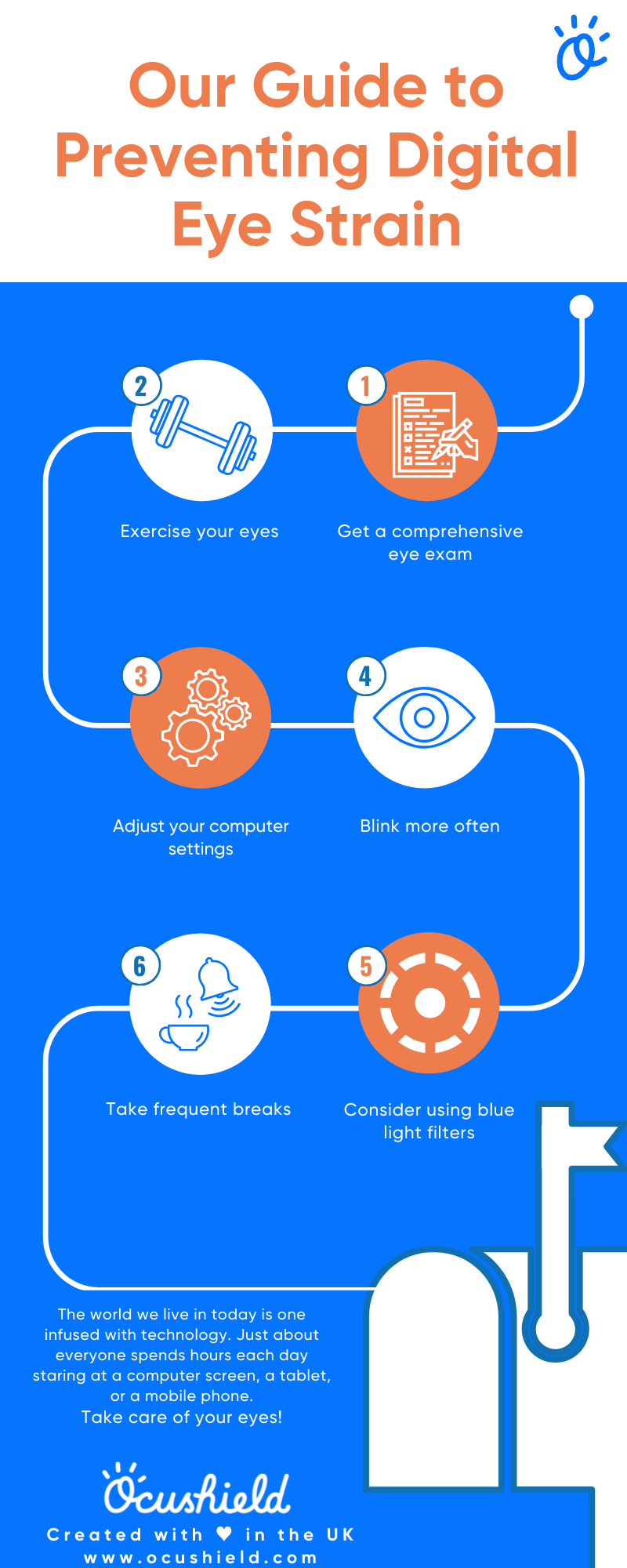
The world we live in today is one infused with technology. Just about everyone spends hours each day staring at a computer screen, a tablet, or a mobile phone. After a day at work spent sitting in front of a screen, many of us continue enjoying the wonders of technology on Netflix or social media. As enjoyable as it may be, prolonged exposure to screens put unnecessary stress on our eyes and result in what we call digital eye strain.
Digital eye strain has several symptoms including eye fatigue, headaches or migraines, blurry vision, shoulder and neck discomfort, eye twitching, and red eyes. Since we live in the digital age, this is inevitable for many of us. It’s important to take precautions and develop good habits to prevent having to experience computer eye syndrome, to begin with.
Here's an infographic with six ways to relieve the screen induced strain on your eyes, rounding up this post if you prefer visuals:

Here are six ways to relieve the screen-induced strain on your eyes:
1. Get a comprehensive eye exam
Eye exams should be an annual part of your health plan. It’s wise to pay a visit to your eye doctor on a regular basis to detect any abnormalities. Your medical practitioner will be able to diagnose and help prevent the progression of any eye problems you may have.
2. Exercise your eyes
Our eyes have muscles too and will need some exercise to prevent or at least minimise the strain in your eyes. Here are a few tips:
- Follow the "20-20-20 rule,” as what most doctors prefer to call it. Every 20 minutes, spent 20 seconds focusing on something 20 feet away. When you are doing so, you are relaxing the focusing muscle inside the eye, minimising strain and fatigue.
- Another exercise is to look far away at a certain object for ten to fifteen seconds, then look at something up close for ten to fifteen seconds.
- Eye rolling is another brilliant exercise for your eyes. To do this, sit up straight, look to your right and move your eyes upward, then to your left and look downward. Repeat at least ten repetitions.
- The eye press is excellent for releasing strain. Close your eyes. Put all your fingers on your eyes with very little pressure. Hold them for about ten seconds. Slowly release your eyes. Open and blink to help your eyes focus. Repeat the process at least ten times.
- Another exercise is figure eights. Sit up straight with your feet flat on the floor. Extend your arm with your thumb sticking out. Trace number 8’s in the air. Repeat the movement at least five times.
3. Adjust your computer settings
Adjusting the settings of your computer screen can help reduce eye strain. Here are three things you should tweak:
- Brightness: The brightness of your screen should be adjusted to a similar level to that of your surroundings. This means that if you’re in a bright room, you should adjust your brightness to be higher. If you’re in a dim-lit room, adjust your brightness accordingly.
- Text size and contrast: Adjust the size of the fonts to something that will not strain your eyes. If you are unable to see what you are typing when you blink, then your fonts are the wrong size.
- Colour temperature: Although this is largely up to preference, warm colour temperature is typically the best.
4. Blink more often
Blinking frequently helps moisten our eyes to prevent dryness and eye irritation. If your eyes have been drying out lately, make blinking a more frequent habit.
5. Consider using blue light filters
If you spend hours a day in front of a screen, consider visiting your eye practitioner for a pair of prescription glasses equipped with blue light lenses. This will help filter out the blue light your eyes are being exposed to on the regular. Another fantastic way to reduce blue light exposure is by adding a blue light filter to your devices. You can do this with the help of films or even applications.
6. Take frequent breaks
Breaks are important for your eyes. Make a point of spending ten minutes away from the computer every hour. Try walking around your office or doing some eye exercises to lessen the strain. These small breaks will also help release tension in your neck and shoulders.
How we reviewed this article:
Ocushield has strict sourcing guidelines and relies on peer-reviewed studies, academic research institutions, and medical associations.
Our experts continually monitor the health and wellness space, and we update our articles when new information becomes available.
Current Version
September 30, 2020

Leave a comment